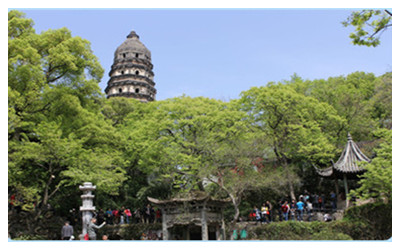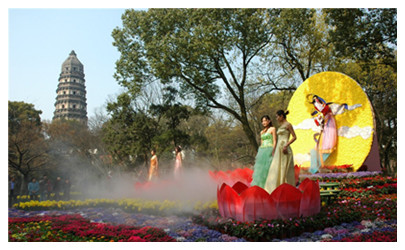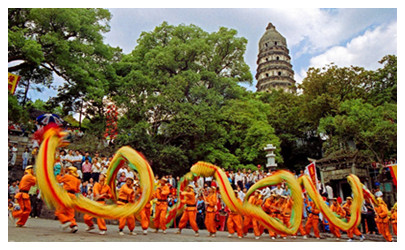Skype: neodalle-travel
Tel: +86 135 7447 2266
E-mail: sales@zhangjiajieholiday.com
Tiger Hill, known also as Surging Sea Hill, is a large hillock covering about 14,100 square metres and only 36 metres in height. Climbing it, you can find a number of historical sites some of which can be traced back over 2,500 years to the founding of Suzhou. Although the hill is relatively small it has rich history. These are just some of the highlights of what to be found there.
 Tiger Hill Pagoda (Huqiu Tower)
Tiger Hill Pagoda (Huqiu Tower)
The pagoda stands on the hill's summit and is the Pagoda of the Yunyan Temple. As the oldest pagoda in the vicinity of Suzhou it has come to be a symbol of the city and has the distinction of being China's Leaning Tower. Built during the Northern Song Dynasty (959-961), it is a seven-storey octagonal tower following the style of the timber pagodas built during the early Tang Dynasty (618-907). It is 158 feet (48 metres) high and for the past four hundred years has leant 3.59 degrees to the northwest.
The Tomb of King He Lu
In 496 BC during the Spring and Autumn Period (770 BC-476 BC), He Lu, King of the Wu State perished during the war fought against the Yue State. His son buried him on the hill and three days after the funeral a white tiger came and sat upon the grave as though guarding it. From that time on it has been known as Tiger Hill.
Lu Yu Well
Lu Yu was an authority on the art of tea and wrote the first ever book on the subject entitled 'The Treatise of Tea'. As an old man, he lived on Tiger Hill and it was here that he wrote the final part of his book. Lu Yu excavated the well and declared that the water from it was the third best throughout China. Consequently, upon the research and teaching of Lu Yu, tea growing and consumption came to be important factors in the daily life of Suzhou citizens.
 Verdant Mountain Villa (Yongcui Shanzhuang)
Verdant Mountain Villa (Yongcui Shanzhuang)
Built in the tenth year of the reign of Emperor Guangxu of theQing Dynasty (1644-1911), the villa is a masterpiece of the splendid gardens for which Suzhou is so famous. As the only garden without lakes or pools in Suzhou, the villa distinguishes itself from others. It was constructed according to the outline of the hill with exquisite pavilions, paths, and decorated by luxuriant woods and flowers. The Verdant Mountain Villa was designed so that it embraced the natural vistas and views from the halls and porches, which are the most pleasing to the eye.
Sword Testing Stone and Sword Pool
King He Lu was a zealous collector of rare swords and it is said that he tested them upon this stone. The crevice thus made in the rock is the only evidence of the existence of these swords, as it is believed that they were buried beneath the Sword Pool as funerary objects. Another mystery that surrounds the tomb is the whereabouts of the remains of the 1,000 workers who built it and who were put to death upon completion of the task.
Wanjing Villa
The ancient art of bonsai tree growing originated in China and there are hundreds of magnificent specimens on display at this  villa. Many of the specimens you can see have been awarded prizes in prestigious bonsai competitions. The miniature replicas of full-sized gardens are sure to amaze you and will give an insight into the skill and artistry of Chinese master gardeners that has been handed down from long ago.
villa. Many of the specimens you can see have been awarded prizes in prestigious bonsai competitions. The miniature replicas of full-sized gardens are sure to amaze you and will give an insight into the skill and artistry of Chinese master gardeners that has been handed down from long ago.
There can be little doubt that Tiger Hill is a wonderful sight with its leaning pagoda, waterfalls and landscaped paths. It is hard to believe that it was man made to be the cemetery of king but this is yet another part of the wonder in China, a land that will never cease to amaze and enthral the visitor with its heritage.
A famous Song Dynasty (960-1279) poet, Su Shi said, 'It is a lifelong pity if having visited Suzhou you did not visit Tiger Hill.' This epitomises the general opinion of those who have seen this local beauty spot with its many attractions that we shall endeavour to describe for you.
Travel Tips
Address: No. 8, Shanmen, Huqiu District, Suzhou, Jiangsu, China
Opening hours: 07:30-17:30
Entrance Fee: CNY 80
 Ask Questions ?
Ask Questions ?